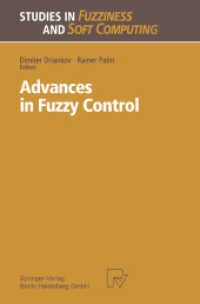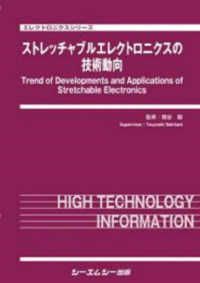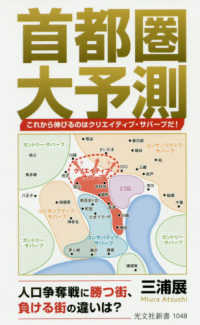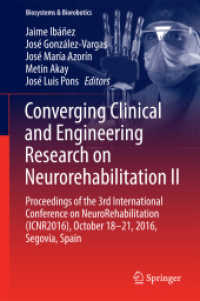- ホーム
- > 洋書
- > 英文書
- > History / World
Full Description
In late antiquity, Zoroastrian exegetes set out to translate their ancient canonical texts intoMiddle Persian, the vernacular of their time. Although undated, these translations, commonly known as the Zand, are often associated with the Sasanian era (224 651 CE). Despite the many challenges the Zand offers to us today, it is indispensable for investigations of late antique exegesis of the Avesta, a collection of religious and ritual texts commonly regarded as the Zoroastrians' scripture.Arash Zeini also offers a fresh edition of the Middle Persian version of the Avestan Yasna Hapta?h?iti, a ritual text composed in the Old Iranian language of Avestan, commonly dated to the middle of the second millennium BCE. Zeini challenges the view that considers the Zand's study an auxiliary science to Avestan studies, framing the text instead within the exegetical context from which it emerged.
Contents
List of Figures xii
List of Tables xii
Acknowledgements xiv
Series Editor's Preface xv
Preface xvi
The Avesta xvi
Zaraϑuštra xvii
The Zand xvii
The Zand and late antiquity xviii
Notes on translating the Zand xviii
Conventions xix
Abbreviations xxi
Languages xxi
Texts xxi
Other abbreviations xxii
Introduction 1
Introduction 2
⒈1 The Yasna Haptaŋhāiti 2
⒈2 The Pahlavi text 5
⒈3 Why a new edition of the PYH? 6
⒈4 The present edition 7
⒈⒋1 Emendatio 8
⒈⒋2 Base text 9
⒈⒋3 Numbering the stanzas of Y 35 11
⒈⒋4 Glosses 11
⒈⒋5 The otiose stroke 14
⒈5 Manuscripts 15
⒈⒌1 Pt4 16
⒈⒌2 Mf4 16
⒈⒌3 F2 17
⒈⒌4 R413 17
iv
⒈⒌5 T6 18
⒈⒌6 E7 19
⒈⒌7 J2 20
⒈⒌8 K5 20
⒈⒌9 M1 20
⒈6 Manuscript filiation 21
The Zand 23
⒉1 Early research 24
⒉2 Marginalisation of texts 26
⒉3 Perceptions of the Zand in Iranian studies 28
Scholasticism 33
⒊1 Strong sense of tradition 36
⒊2 Concern with language 40
⒊3 Proliferativity 42
⒊4 Completeness and compactness 45
⒊5 Epistemological accessibility of the world 45
⒊6 Systematicity 47
⒊7 Self-reflexivity 48
⒊8 Summary 49
Fire in Zoroastrianism 52
⒋1 The Older Avesta 53
⒋⒈1 The Gāϑās 54
⒋⒈⒈1 aṣ̌a- 54
⒋⒈⒈2 Distributor 55
⒋⒈⒈3 rāna- 55
⒋⒈⒈4 Protection 56
⒋⒈2 The YH 57
⒋⒈3 Summary 58
⒋2 The Younger Avesta 60
⒋⒉1 Summary 62
⒋3 Pahlavi literature 63
⒋⒊1 The Gāϑic fire in the Zand 63
⒋⒊2 PY ⒘11 65
⒋⒊3 Bundahišn 67
⒋⒊4 Pahlavi Rivāyat accompanying the Dādestān ī Dēnīg 68
⒋⒊5 Wizīdagīhā ī Zādspram 68
⒋⒊6 Dēnkard 71
⒋⒊7 Summary 75
⒋4 Correlative systems 75
⒋5 Summary 78
Precis: yasn ī haft hād 81
⒌1 PY 35 81
⒌⒈1 humatān hūxtān huwarštān 81
⒌⒈2 The dēn 82
⒌⒈3 PY 3⒌1 85
⒌2 PY 36 86
⒌⒉1 The three steps 86
⒌3 PY 37 90
⒌4 PY 38 91
⒌5 PY 39 91
⒌6 PY 40 92
⒌⒍1 A commitment to the dēn 92
⒌7 PY 41 94
⒌⒎1 PY 4⒈4 95
⒌⒎2 PY 4⒈6: ān ī ōy 'that which is his' 95
⒌⒎3 hamē tā ō wisp 'always until all' 98
Text & translation 101
6 PY 35 102
⒍1 PY 3⒌0 102
⒍2 PY 3⒌1 103
⒍3 PY 3⒌2 104
⒍4 PY 3⒌3 105
⒍5 PY 3⒌4 106
⒍6 PY 3⒌5 107
⒍7 PY 3⒌6 108
⒍8 PY 3⒌7 109
⒍9 PY 3⒌8 110
⒍10 PY 3⒌9 111
7 PY 36 112
⒎1 PY 3⒍1 112
⒎2 PY 3⒍2 113
⒎3 PY 3⒍3 114
⒎4 PY 3⒍4 115
⒎5 PY 3⒍5 116
⒎6 PY 3⒍6 117
8 PY 37 118
⒏1 PY 3⒎1 118
⒏2 PY 3⒎2 119
⒏3 PY 3⒎3 120
⒏4 PY 3⒎4 121
⒏5 PY 3⒎5 122
9 PY 38 123
⒐1 PY 3⒏1 123
⒐2 PY 3⒏2 124
⒐3 PY 3⒏3 125
⒐4 PY 3⒏4 126
⒐5 PY 3⒏5 127
10 PY 39 128
⒑1 PY 3⒐1 128
⒑2 PY 3⒐2 129
⒑3 PY 3⒐3 130
⒑4 PY 3⒐4 131
⒑5 PY 3⒐5 132
11 PY 40 133
⒒1 PY 40.1 133
⒒2 PY 40.2 135
⒒3 PY 40.3 136
⒒4 PY 40.4 137
12 PY 41 138
⒓1 PY 4⒈1 138
⒓2 PY 4⒈2 139
⒓3 PY 4⒈3 140
⒓4 PY 4⒈4 141
⒓5 PY 4⒈5 142
⒓6 PY 4⒈6 143
Miscellaneous observations 144
13 PY 35 145
⒔1 PY 3⒌0 145
⒔⒈1 yazom 145
⒔⒈2 kē radīh pad frārōnīh 147
⒔⒈3 hudahāgān 152
⒔⒈4 kē-iz 153
⒔⒈5 pad ārzōg 154
⒔⒈6 mazdēsnān 154
⒔2 PY 3⒌1 156
⒔⒉1 dahišn 156
⒔⒉2 HkL& hom 157
⒔⒉3 abar griftār 157
⒔⒉4 ō xwēš kardan 158
⒔⒉5 mard ō mard 158
⒔3 PY 3⒌2 162
⒔⒊1 hād 162
⒔4 PY 3⒌3 163
⒔⒋1 PY 3⒌3a 163
⒔5 PY 3⒌4 165
⒔6 PY 3⒌5 166
⒔⒍1 PY 3⒌5a 166
⒔⒍2 PY 3⒌5c 166
⒔7 PY 3⒌6 167
⒔⒎1 Text division 167
⒔⒎2 PY 3⒌6a 167
⒔⒎3 ašmā 167
⒔8 PY 3⒌7 169
⒔⒏1 wālunīh 169
⒔9 PY 3⒌8 170
14 PY 36 172
⒕1 PY 3⒍1 172
⒕⒈1 pad warzišn 172
⒕2 PY 3⒍2 173
⒕⒉1 kār 173
⒕3 PY 3⒍3 175
⒕⒊1 The fire of the exegetes 175
⒕4 PY 3⒍5 176
⒕⒋1 abāmēne 176
⒕⒋2 〈hlwstˈ〉 177
⒕5 PY 3⒍6 178
⒕⒌1 PY 3⒍6 178
⒕⒌2 sraēštąm 'nēk' 178
⒕⒌3 niwēyēnišn dahom 180
15 PY 37 181
⒖1 PY 3⒎1 181
⒖⒈1 Y 5 181
⒖⒈2 iϑā 181
⒖⒈⒉1 iϑā in MP literature 182
⒖⒈⒉2 iϑā in the Older Avesta 184
⒖⒈3 āt̰ 'ēdōn' 189
⒖⒈4 iϑā āt̰ 'ēdar ēdōn' 190
⒖⒈5 The creations 194
⒖⒈6 bun ud bar 196
⒖⒈7 (P)Y 3⒎1b 199
⒖2 PY 3⒎2 202
⒖⒉1 ōy kē ... aziš 202
⒖3 PY 3⒎3 204
⒖⒊1 tan ud ǰān 204
⒖⒊2 narān 204
⒖4 PY 3⒎4 206
⒖⒋1 amahraspandān 206
16 PY 38 207
⒗1 PY 3⒏1 207
⒗⒈1 mādagān 207
⒗⒈2 az ahlāyīh abāgīh 208
⒗2 PY 3⒏2 209
⒗⒉1 īžā- 209
⒗⒉2 yaošti- 209
⒗⒉3 fərašti- 209
⒗⒉4 ārmaiti- 209
⒗3 PY 3⒏3 210
⒗⒊1 PY 3⒏3 210
⒗⒊2 The waters 210
⒗⒊3 hudahagīh 213
⒗⒊4 hušnāyišnagīh 214
⒗4 PY 3⒏4 215
⒗⒋1 *dadag 215
⒗⒋2 wehdahāg 215
⒗5 PY 3⒏5 217
⒗⒌1 PY 6⒎6-8 217
⒗⒌2 xōn 217
17 PY 39 219
⒘1 PY 3⒐1 219
⒘⒈1 ǰān 219
⒘⒈2 amāgān 220
⒘⒈3 ā-š dād 220
⒘2 PY 3⒐2 221
⒘⒉1 PY 3⒐2 221
⒘⒉2 daitīkān-iz 221
⒘⒉3 wānīdār ... windišn ...weh mard 222
⒘⒉⒊1 wānīdār 222
⒘⒉⒊2 windišn 222
⒘⒉⒊3 weh mard 223
⒘3 PY 3⒐3 224
⒘⒊1 āt̰ iϑā 'ān ēdōn' 224
⒘⒊2 weh nar ān ī weh mādag 224
⒘4 PY 3⒐4 226
⒘5 PY 3⒐5 227
⒘⒌1 Recitation instructions 227
18 PY 40 228
⒙1 PY 40.1 228
⒙⒈1 mehīh 228
⒙⒈2 man 228
⒙⒈3 PY 40.1b 228
⒙⒈4 manīgān 229
⒙2 PY 40.3 230
⒙⒉1 ān hērbed 230
⒙⒉2 amāgān 230
⒙3 PY 40.4 231
⒙⒊1 īšt 231
19 PY 41 232
⒚1 PY 4⒈2 232
⒚2 PY 4⒈5 234
⒚⒉1 hēnd 234
⒚⒉2 Recitation instructions 234
Epilogue 235
20 Reflections on the Zand 236
⒛1 WBW translation 237
⒛2 Simplified morphology 241
⒛3 Translation techniques 241
⒛4 Auxiliary science 243
⒛5 Transmission 244
⒛6 Concluding thoughts 248
Appendices 251
A Transliteration & apparatus 252
A.1 PY 5 252
A.⒈1 PY ⒌1 252
A.⒈2 PY ⒌2 254
A.⒈3 PY ⒌3 255
A.⒈4 PY ⒌4 256
A.⒈5 PY ⒌5 257
A.⒈6 PY ⒌6 258
A.2 PY 35 259
A.⒉1 PY 3⒌0 259
A.⒉2 PY 3⒌1 261
A.⒉3 PY 3⒌2 262
A.⒉4 PY 3⒌3 263
A.⒉5 PY 3⒌4 265
A.⒉6 PY 3⒌5 266
A.⒉7 PY 3⒌6 268
A.⒉8 PY 3⒌7 269
A.⒉9 PY 3⒌8 270
A.⒉10 PY 3⒌9 271
A.3 PY 36 273
A.⒊1 PY 3⒍1 273
A.⒊2 PY 3⒍2 275
A.⒊3 PY 3⒍3 276
A.⒊4 PY 3⒍4 277
A.⒊5 PY 3⒍5 278
A.⒊6 PY 3⒍6 279
A.4 PY 37 281
A.⒋1 PY 3⒎1 281
A.⒋2 PY 3⒎2 282
A.⒋3 PY 3⒎3 283
A.⒋4 PY 3⒎4 284
A.⒋5 PY 3⒎5 285
A.5 PY 38 286
A.⒌1 PY 3⒏1 286
A.⒌2 PY 3⒏2 287
A.⒌3 PY 3⒏3 289
A.⒌4 PY 3⒏4 292
A.⒌5 PY 3⒏5 293
A.6 PY 39 296
A.⒍1 PY 3⒐1 296
A.⒍2 PY 3⒐2 297
A.⒍3 PY 3⒐3 299
A.⒍4 PY 3⒐4 300
A.⒍5 PY 3⒐5 302
A.7 PY 40 304
A.⒎1 PY 40.1 304
A.⒎2 PY 40.2 306
A.⒎3 PY 40.3 307
A.⒎4 PY 40.4 309
A.8 PY 41 310
A.⒏1 PY 4⒈1 310
A.⒏2 PY 4⒈2 311
A.⒏3 PY 4⒈3 312
A.⒏4 PY 4⒈4 314
A.⒏5 PY 4⒈5 315
A.⒏6 PY 4⒈6 316
B Y 9.1 318
B.1 miϑrō ziiāt̰ zaraϑuštrəm 318
B.⒈1 Distribution 319
B.⒈⒈1 IrPY 319
B.⒈⒈2 InPY 319
B.⒈⒈3 SktY 319
B.⒈⒈4 IrYS 320
B.⒈⒈5 InYS 320
B.⒈⒈6 IrWdS 320
B.⒈⒈7 InWdS 320
B.⒈⒈8 IrWrS 320
B.⒈⒈9 InWrS 320
C
Fire in the Older Avesta
322
D
iϑā
324
E
MSS Concordance
327
Bibliography 328








